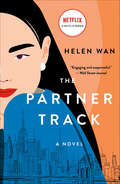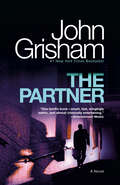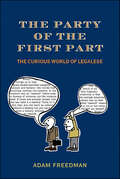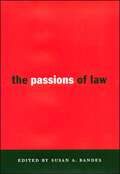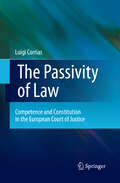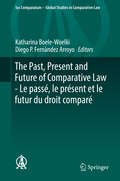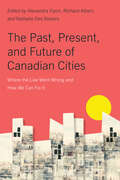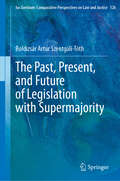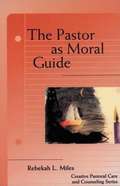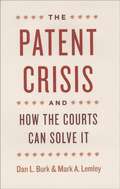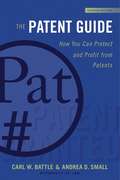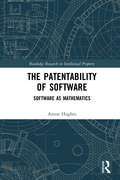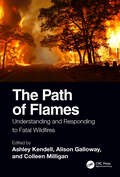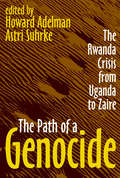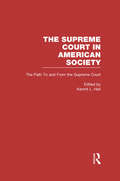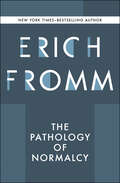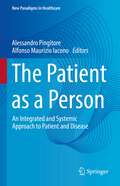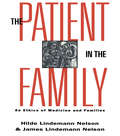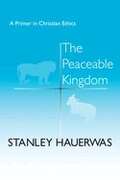- Table View
- List View
The Partner Track: A Novel
by Helen WanAn “engaging and suspenseful” novel of a first-generation Chinese American having second thoughts about her elite Manhattan law firm (The Wall Street Journal).Ingrid Yung’s life is full of firsts. A first-generation Chinese American, the first lawyer in her family, she’s about to collect the holy grail of firsts and become the first minority woman to make partner at the venerable old Wall Street law firm Parsons Valentine & Hunt.Ingrid has perfected the art of “passing” and seamlessly blends into the old-boy corporate culture. She gamely banters in the cafeteria, plays in the firm softball league, and earnestly racks up her billable hours. But when an offensive incident at the summer outing threatens the firm’s reputation, Ingrid’s outsider status is suddenly thrown into sharp relief.Scrambling to do damage control, Parsons Valentine announces a new diversity and inclusion initiative, commanding Ingrid to spearhead the effort—just as she’s about to close an enormous transaction that was to be her final step in securing partnership.For the first time, Ingrid begins to question her place in the firm. Pitted against her colleagues, including her golden-boy boyfriend, Ingrid wonders whether the prestige of partnership is worth breaching her ethics. But can she risk throwing away the American dream that’s finally within her reach?“Thought-provoking . . . [a] compelling tale.” —Booklist“Funny, fragile, sometimes bold, often unsure, Ingrid Yung is one of those unforgettable heroines that you actually miss, like a dear friend, when the story’s over.’“—Ann Leary, New York Times–bestselling author of The Foundling“Intriguing and entertaining.” —Library Journal
The Partner: A Novel (Pearson English Graded Readers Ser.)
by John Grisham#1 NEW YORK TIMES BESTSELLER • Once he was a well-liked, well-paid young partner in a thriving Mississippi law firm. Then he stole ninety million dollars from his own firm—and ran for his life.&“One terrific book—smart, fast, stingingly satiric, and almost criminally entertaining.&”—Entertainment WeeklyFor four years Patrick Lanigan evaded men who were rich and powerful, and who would stop at nothing to find him. Then, inevitably, on the edge of the Brazilian jungle, they finally tracked him down.Now Patrick is coming home. And in the Mississippi city where it all began, an extraordinary trial is about to begin. As prosecutors circle like sharks, as Patrick&’s lawyer prepares his defense, as Patrick&’s lover prays for his deliverance and his former partners wait for their revenge, another story is about to emerge. Because Patrick Lanigan, the most reviled white-collar criminal of his time, knows something that no one else in the world knows. He knows the truth.
The Party of the First Part: The Curious World of Legalese
by Adam FreedmanThe Eats, Shoots & Leaves of legalese, this witty narrative journey through the letter of the law offers something for language lovers and legal eagles alikeThis clever, user-friendly discourse exposes the simple laws lurking behind decorative, unnecessary, and confusing legal language. For better or for worse, the instruction manual for today's world is written by lawyers. Everyone needs to understand this manual-but lawyers persist in writing it in language no one can possibly decipher.Why accuse someone of making "material misstatements of fact," when you could just call them a liar? What's the point of a "last" will and testament if, presumably, every will is your last? Did you know that "law" derives from a Norse term meaning "that which is laid down"? So tell your boss to stop laying down the law-it already is.The debate over Plain vs. Precision English rages on in courtrooms, boardrooms, and, yes, even bedrooms. Here, Adam Freedman explores the origins of legalese, interprets archaic phrasing (witnesseth!), explains obscure and oddly named laws, and disputes the notion that lawyers are any smarter than the rest of us when judged solely on their briefs. (A brief, by the way, is never so.)
The Passions of Law (Critical America #67)
by Susan BandesThe Passions of Law is the first anthology to treat the role that emotions play, don't play, and ought to play in the practice and conception of law and justice. Lying at the intersection of law, psychology, and philosophy, this emergent field of law scholarship raises some of the most profound and interesting questions at the heart of jurisprudence. For example, what role do emotions ranging from disgust to compassion play in the decision-making processes of judges, lawyers, juries, and clients? What emotions belong in which legal contexts? Is there a hierarchy of emotions, and, if so, through what sources do we identify it? To what extent are emotions subject to change or tutelage? How can we evaluate the role of emotion in such disparate contexts as death sentencing, laws about same sex marriage, hate crime legislation, punitive damages or shaming penalties? Consisting of original essays by leading scholars of law, theology, political science, and philosophy, The Passions of Law contributes to ongoing efforts to humanize law and reveals how this previously unacknowledged aspect of decision-making exerts a much greater impact on justice and the practice of law than most tend, or like, to think. Learn more about Susan Bandes
The Passivity of Law
by Luigi CorriasAt the heart of this book, a question: what to make of the creeping competences of the EU and of the role the European Court of Justice plays in this respect? Taking the implied powers doctrine as its starting point, the hypothesis is that it shows what is ultimately at stake in the concept of legal competence: the problem of creation in law, or the relationship between constituent and constituted power. By rethinking this relationship, a new conceptual framework to make sense of creeping competences is designed. For this, the work of Maurice Merleau-Ponty is used. Tracing back the philosophical roots of creation, legal constitution is understood as constitution in passivity. This leads to a whole new interpretation of the relationship between law and politics, rule following, authority, competences and European integration. From this perspective specific chapters in the case law of the European Court of Justice are reread and the logic behind the competence creep is unmasked. new back cover copy: Europe's constitutional journey has not been a smooth one, and a better division and definition of competence in the European Union is a key issue that needs to be addressed. How can the division of competence be made more transparent? Does there need to be a reorganization of competence? How can it be ensured that the redefined division of competence will not lead to a creeping expansion of the competence of the Union or to encroachment upon the exclusive areas of competence of the Member States and, where there is provision, regions? And how can it be ensured that the European dynamic does not come to a halt? Indeed, has the creeping expansion of the competence of the Union already come to a halt? These are the questions this book explores. The Passivity of Law: Competence and Constitution in the European Court of Justice opens with a legal account of competence creep, including the role that the European Court of Justice plays in it and a sketch of the present division of competences and the main principles regulating it. It then discusses the relationship between constituent power and constituted or constitutional power from the viewpoint of the history of constitutional history before offering an alternative theory of their relationship, known as "chiastic theory," which is based on the philosophical investigations of Merleau-Ponty. It details how chiastic theory can be used to make sense of the Court's role in the competence creep in general and the doctrine of implied powers in particular, and it utilizes several case studies concerning competences to sustain this claim. Aimed at researchers and practitioners in Philosophy, Phenomenology, Political Science, the Social Sciences and numerous fields of law, this monograph is a seminal work in the evolving theory and practice of EU law.
The Past, Present and Future of Comparative Law - Le passé, le présent et le futur du droit comparé: Ceremony of 15 May 2017 in Honour of 5 Great Comparatists - Cérémonie du 15 mai 2017 en l'honneur de 5 grands comparatistes (Ius Comparatum - Global Studies in Comparative Law #29)
by Katharina Boele-Woelki Diego P. Fernàndez ArroyoThis book is published by the International Academy of Comparative Law to honor five great comparatists: Jean-Louis Baudouin from Canada, Xavier Blanc-Jouvan from France, Mary Ann Glendon from the United States of America, Hein Kötz from Germany, and Rodolfo Sacco from Italy. The five great minds present their thoughts on the past, the present and future of comparative law and in doing so they particularly focus on the future of the International Academy of Comparative Law, comparative law methodology and the teaching of comparative law. The book is essential reading for researchers and academics wanting to know what these respected legal scholars have contributed to comparative law, how they differ and when and why they excelled. Moreover, the views presented suggest how the role of the Academy can be developed in order to deal with the current challenges of comparative law.Ce livre est publié par l'Académie internationale de droit comparé en l'honneur de cinq grands comparatistes : Jean-Louis Baudouin du Canada, Xavier Blanc-Jouvan de France, Mary Ann Glendon des États-Unis, Hein Kötz d'Allemagne et Rodolfo Sacco d'Italie. Ces cinq grands esprits offrent leurs réflexions sur le passé, le présent et le futur du droit comparé et, ce faisant, se concentrent particulièrement sur l'avenir de l'Académie internationale de droit comparé, la méthodologie ainsi que l'enseignement du droit comparé. Ce livre est une lecture essentielle pour les chercheurs et les universitaires qui s’intéressent aux contributions au droit comparé de ces juristes respectés, la manière dont ils diffèrent et quand et pourquoi ils ont excellé. De plus, les points de vue présentés suggèrent comment le rôle de l'Académie peut être développé pour faire face aux défis actuels du droit comparé.
The Past, Present and Future of Sustainable Management: From the Conservation Movement to Climate Change
by Stephen Cummings Todd BridgmanWe might think sustainable management is a new idea, created in the 1960s by enlightened modern scientists. We might think that it puts us on a new path, beyond what management was originally about. But this is not true. Sustainable management is as old as civilization and was a foundation stone of management science as it was formed in the first decade of the 20th century. Recovering this forgotten past provides deeper roots and greater traction to advance sustainable management in our own times.This book charts a history of sustainable management from premodern times, through the birth of management science as an offshoot of the conservation movement, to the present day. The authors argue that modern tools like Triple Bottom Line reporting and multiple Sustainable Development Goals may be less useful than a return to a more fundamental and holistic view of management.
The Past, Present, and Future of Canadian Cities: Where the Law Went Wrong and How We Can Fix It (McGill-Queen's Studies in Urban Governance #19)
by Alexandra Flynn, Richard Albert, and Nathalie Des RosiersIn 1861, just a few years before Confederation, 84 per cent of Canadians lived in rural areas; today, it’s less than 20 per cent. Our municipal governments are asked to do more for their citizens than ever before, yet they must confront myriad challenges – from the public health pandemic to the housing crisis – without the tools they need. They have no constitutional protection from jurisdictional overstepping by provincial governments and no assurance that they will be able to complete any effort they undertake.The Past, Present, and Future of Canadian Cities explores the historical functions of municipalities, their current ability to tackle major problems, and what the future holds for shifting legal and political powers. This volume examines how pre-Confederation cities came to have their current constitutional and legislative forms; how current local governments make decisions within existing legal parameters, highlighting Indigenous-municipal relationships and emergency management; and, finally, looks to the world to investigate future innovation in municipal governance.The Past, Present, and Future of Canadian Cities makes the case that constitutional concepts must be repurposed to support the transition from nation-building to city-building in a global context.
The Past, Present, and Future of Legislation with Supermajority (Ius Gentium: Comparative Perspectives on Law and Justice #126)
by Boldizsár Artúr Szentgáli-TóthThis book revisits the main challenges raised by the implementation of supermajority legislation – a constitutionally prescribed subcategory of statutory norms that covers, at least in principle, the most important fields of legislation, and which is subject to stricter procedural requirements than the ordinary legislative process. The book puts the issue in a broader context, yielding valuable comparative insights. It lays the theoretical groundwork for the interdisciplinary assessment of supermajority law concepts, which are ranked somewhere between the constitutional and statutory level in the legal pyramid. To cite the most important example, there is still no coherent standard to help constitutional courts decide whether individual statutory provisions should be covered by supermajority legislation or ordinary legislation. The three main points of departure are the following: Firstly, the book posits that supermajority shall be distinguished from ordinary laws as a separate constitutional concept and a category of legal sources with a legal rank falling clearly under the constitution, but over ordinary laws. The second assumption states that due to several short-comings, the current procedural frameworks of supermajority law could not maximize its efficiency as a constitutional instrument. Other tools might better highlight the role of supermajority laws as safeguards vis-á-vis their currently mostly restrictive character. Thirdly, the book relies on the assumption that the current concept of supermajority law covers an overbroad range of statutes. Therefore, the volume argues for the necessity of narrowing the supermajority legislation to counterbalance the distortive effects of this framework. In light of these three considerations, more legitimate alternative directions can be identified to further develop the existing main models: the scope of this legal instrument might be diminished; mandatory a priori review might be established; while the reconsideration of the legislative process; or the elaboration of precise contours for the hierarchy of norms might also be necessary. This book is intended for policymakers, scholars and university students interested in understanding the mechanisms of parliamentary legislation in more depth.
The Pastor as Moral Guide
by Rebekah L. MilesAdultery, divorce, racism, teen pregnancy, white-collar crime, living wills-these are among the many complex moral issues that Christians face and for which they often seek guidance from their pastors. This book is designed to assist pastors in developing their skills in providing moral guidance to their parishioners in a culture characterized by both ethical confusion and increasingly complex moral choices. Rebekah Miles, a gifted thinker and writer, guides the reader through the landscape of the moral life and offers a simple but profound map of the moral terrain along with practical tools to enable pastoral caregivers to serve more effectively as moral guides.
The Patent Crisis and How the Courts Can Solve It
by Dan L. Burk Mark A. LemleyPatent law is crucial to encourage technological innovation. But as the patent system currently stands, diverse industries from pharmaceuticals to software to semiconductors are all governed by the same rules even though they innovate very differently. The result is a crisis in the patent system, where patents calibrated to the needs of prescription drugs wreak havoc on information technologies and vice versa. According to Dan L. Burk and Mark A. Lemley in The Patent Crisis and How the Courts Can Solve It, courts should use the tools the patent system already gives them to treat patents in different industries differently. Industry tailoring is the only way to provide an appropriate level of incentive for each industry. Burk and Lemley illustrate the barriers to innovation created by the catch-all standards in the current system. Legal tools already present in the patent statute, they contend, offer a solution--courts can tailor patent law, through interpretations and applications, to suit the needs of various types of businesses. The Patent Crisis and How the Courts Can Solve It will be essential reading for those seeking to understand the nexus of economics, business, and law in the twenty-first century.
The Patent Guide: How You Can Protect and Profit from Patents (Second Edition) (Allworth Intellectual Property Made Easy)
by Carl W. Battle Andrea D. Small"Recommended." —Library Journal Coming up with a million-dollar idea is only the first step in what might seem like a long and difficult process. In The Patent Guide, Second Edition, experienced patent attorneys Carl W. Battle and Andrea D. Small deliver basic and comprehensive advice that is easy to understand and will allow you to protect, promote, and profit from your ideas. Chapters discuss such topics as: How to commercialize your invention Where to find sources of information and assistance What guidelines you should follow when obtaining a patent How to obtain foreign patent rights How to maintain confidentiality of your ideas When to use patent attorneys and agents How to deal with invention brokers and promotion firms How to enforce your patent against infringement Fully updated and revised, this new edition includes information on inventor notebooks and records, updates to the patent filing process in the United States and abroad, the latest USPTO forms and templates, and changes to electronic filing and submission procedures. With easy-to-use forms and step-by-step instructions, The Patent Guide is an indispensable tool to help minimize costs and maximize profits of your ideas and inventions.
The Patentability of Software: Software as Mathematics (Routledge Research in Intellectual Property)
by Anton HughesThis book explores the question of whether software should be patented. It analyses the ways in which the courts of the US, the EU, and Australia have attempted to deal with the problems surrounding the patentability of software and describes why it is that the software patent issue should be dealt with as a patentable subject matter issue, rather than as an issue of novelty or nonobviousness. Anton Hughes demonstrates that the current approach has failed and that a fresh approach to the software patent problem is needed. The book goes on to argue against the patentability of software based on its close relationship to mathematics. Drawing on historical and philosophical accounts of mathematics in pursuit of a better understanding of its nature and focusing the debate on the conditions necessary for mathematical advancement, the author puts forward an analytical framework centred around the concept of the useful arts. This analysis both explains mathematics’, and therefore software’s, nonpatentability and offers a theory of patentable subject matter consistent with Australian, American, and European patent law.
The Patentability of Synthetic Biology Inventions: New Technology, Same Patentability Issues?
by Ilaria de LisaThis book addresses Synthetic Biology (SynBio), a new and promising biotechnology that has attracted much interest from both a scientific and a policy perspective. Yet, questions concerning the patentability of SynBio inventions have not been examined in detail so far; as a result, it remains unclear whether these inventions are patentable on the basis of current norms and case law. The book addresses this question, focusing especially on the subject matter’s eligibility and moral criteria. It provides an overview of the legislation and decisions applicable to SynBio patents and examines this new technology in view of the ongoing debate over the patentability of biotechnologies in general. The legal analysis is complemented by the practical examination of several patent applications submitted to the European and US patent offices (EPO and USPTO), and by an assessment of the patent issues that are likely to be raised by future SynBio developments.
The Path of Flames: Understanding and Responding to Fatal Wildfires
by Alison Galloway Ashley Kendell Colleen MilliganThe Path of Flames: Understanding and Responding to Fatal Wildfires is an edited volume covering the complexities of response and recovery issues relative to catastrophic wildfires. As wildfires become more frequent throughout the world—and the loss of life greater, especially among residents trapped in the path of the flames—it is essential that agencies in fire-prone areas understand the complexity of the response as it relates to finding and identifying the remains of those who perished. While covering wildfire dynamics, risks for vulnerable populations, and the emergency response to wildfires, this book focuses largely on the recovery of human remains within the context of the overall response to mass disasters resulting from wildfires. As such, search protocols, staffing needs, pre-event coordination and organization, and logistical support are addressed. The scientific basis for understanding how fire will affect human remains—as well as how the level of destruction can be interpreted—is also addressed. Recognizing the multidisciplinary nature of the field, this volume covers forensic issues relating to the recovery of remains, forensic anthropology, DNA analysis, forensic odontology, and forensic pathology. The book also includes contributions from international wildfire response professionals looking at global best practices in wildfire response and human remains recovery. Specifically, several chapters cover the lessons learned from the devasting Camp Fire of 2018 in California that led to the deaths of 85 people. The Camp Fire burned nearly 19,000 structures and was ultimately the most destructive—and deadly—in California’s history. The Path of Flames is a one-of-a-kind reference that serves as a valuable resource for professionals working in the areas of emergency services, search and rescue, law enforcement, fire service, disaster planning and response, victim recovery and identification, and mass disaster and mass fatality response.
The Path of a Genocide: The Rwanda Crisis from Uganda to Zaire
by Astri SuhrkeThe Great Lakes region of Africa has seen dramatic changes. After a decade of war, repression, and genocide, loosely allied regimes have replaced old-style dictatorships. The Path of a Genocide examines the decade (1986-97) that brackets the 1994 genocide in Rwanda. This collection of essays is both a narrative of that event and a deep reexamination of the international role in addressing humanitarian issues and complex emergencies.Nineteen donor countries and seventeen multilateral organizations, international agencies, and international nongovernmental organizations pooled their efforts for an in-depth evaluation of the international response to the conflict in Rwanda. Original studies were commissioned from scholars from Uganda, Rwanda, Zaire, Ethiopia, Norway, Great Britain, France, Canada, and the United States. While each chapter in this volume focuses on one dimension of the Rwanda conflict, together they tell the story of this unfolding genocide and the world's response.The Path of a Genocide offers readers a perspective in sharp contrast to the tendency to treat a peace agreement as the end to conflict. This is a detailed effort to make sense of the political crisis and genocide in Rwanda and the effects it had on its neighbors.
The Path to and From the Supreme Court: The Supreme Court in American Society (The\supreme Court In American Society Ser. #Vol. 3)
by Kermit L. HallAvailable as a single volume or part of the 10 volume set Supreme Court in American Society
The Pathologies of Individual Freedom: Hegel's Social Theory (Princeton Monographs in Philosophy #30)
by Axel HonnethThis is a penetrating reinterpretation and defense of Hegel's social theory as an alternative to reigning liberal notions of social justice. The eminent German philosopher Axel Honneth rereads Hegel's Philosophy of Right to show how it diagnoses the pathologies of the overcommitment to individual freedom that Honneth says underlies the ideas of Rawls and Habermas alike. Honneth argues that Hegel's theory contains an account of the psychological damage caused by placing too much emphasis on personal and moral freedom. Although these freedoms are crucial to the achievement of justice, they are insufficient and in themselves leave people vulnerable to loneliness, emptiness, and depression. Hegel argues that people must also find their freedom or "self-realization" through shared projects. Such projects involve the three institutions of ethical life--family, civil society, and the state--and provide the arena of a crucial third kind of freedom, which Honneth calls "communicative" freedom. A society is just only if it gives all of its members sufficient and equal opportunity to realize communicative freedom as well as personal and moral freedom.
The Pathology of Normalcy
by Erich FrommThe legendary social psychologist and New York Times–bestselling author meditates on ideas of mental health and normalcy in contemporary society. At the beginning of the 1950s, Erich Fromm increasingly questioned whether people in contemporary industrial society were mentally healthy. Eventually the topic of various lectures, Fromm&’s new social psychoanalytic approach enabled him to further develop the psychoanalytic method into a comprehensive critique of the pathology of the &“normal,&” socially adjusted human being. He was thus able to subject to a radical analysis the widespread strivings that dominate behavior in society—and therefore question what is &“normal,&” what is beneficial to mental health, and what makes people ill. In The Pathology of Normalcy, Fromm examines the concepts of mental health and mental illness in modern society. He discusses, through a series of lectures, subjects including a frame of reference for evaluating mental health, the relationship between mental health issues and alienation, and the connection between psychological and economic theory. Finally, he elucidates how humanity can overcome &“the insane society,&” as well as its own innate laziness.
The Patient Revolution: How We Can Heal the Healthcare System
by David GilbertThe NHS is in crisis - it's in record demand, and care services are at breaking point - but what if the solution to rescuing the NHS is in the hands of the patients themselves?In this refreshingly positive and remarkable book, David Gilbert shares the powerful real-life stories of 'patient leaders' - ordinary people affected by life-changing illnesses, disabilities, or conditions, who have all gone back into the fray to help change the healthcare system in necessary and inspiring ways. Charting their diverse journeys - from managing to live with their condition, and their motivation to change the status quo, right through to their successes in improving approaches to health and social care - these moving and courageous stories aim to motivate others to take back control and showcase the pivotal importance of patients as genuine decision-making leaders.Filled with hard-won wisdom and everyday heroism, The Patient Revolution challenges current discourse and sets out an empowering vision of how patient leaders can change the future of healthcare.
The Patient as a Person: An Integrated and Systemic Approach to Patient and Disease (New Paradigms in Healthcare)
by Alfonso Maurizio Iacono Alessandro PingitoreIn the current era, evidence-based medicine and various supporting technologies dominate everyday clinical practice, according to a disease-centred, as opposed to patient-centred, approach. They have obviously improved the clinical management of diseases and it is therefore unreasonable to think of a medicine in which they are not considered fundamental. In fact, the strength of the new medicine should be to adapt scientific knowledge to a specific clinical case. This book therefore looks at the prospect of a new 'person' centred medicine, which stands alongside the 'disease' and 'patient' centred medicine, which pays special attention to the subjectivity of scientific knowledge and the relationship between doctor and patient. It is important to emphasise that this book is written by several hands, i.e. by experts from different fields, doctors, philosophers, architects, sociologists, art critics, physicists and engineers. This is with the intention of providing as broad a perspective as possible on the doctor-patient relationship. Due to its translational and multicultural approach to the subject, the book will be of interest to a wide readership, from medical experts to students, psychologists, philosophers and institutional actors.
The Patient in the Family: An Ethics of Medicine and Families (Reflective Bioethics)
by James Lindemann Nelson Hilde Lindemann NelsonThe Patient in the Family diagnoses the ways in which the worlds of home and hospital misunderstand each other. The authors explore how medicine, through its new reproductive technologies, is altering the structure of families, how families can participate more fully in medical decision-making, and how to understand the impact on families when medical advances extend life but not vitality.
The Peace: A Warrior's Journey
by Romeo DallaireInternational humanitarian icon and bestselling author General Roméo Dallaire guides readers on a crucial and inspiring journey from past wars through post-modern conflict toward a vision of lasting peace.In The Peace, Roméo Dallaire shows us the past, present and future of war through the prism of his own life. Trained in classic warfare during the Cold War era of mutual deterrence, Dallaire in good faith commanded the UN&’s peacekeeping mission for Rwanda in 1994, only to see the country abandoned and descend into the hell of genocide. The battered, tortured warrior who emerged from that catastrophe grew determined to help repair the new world disorder—to prevent genocide, abolish the use of child soldiers, and find ways to intervene in, even prevent, conflicts in defence of humanity. And so Dallaire helped advance the doctrines of Responsibility to Protect and the Will to Intervene only to witness those initiatives falter because of the same old power politics, national self-interest and general indifference that had allowed the genocide in Rwanda to unfold unchecked. In his final act, Dallaire has become a warrior working towards a better future in which those old paradigms are rejected and replaced. In The Peace he calls out the elements that undermine true security because they reinforce the dangerous, self-interested belief that &“balance&” of power and truces are the best we can do. Too often we say we are &“at peace&” because the bombs are falling elsewhere and we, ourselves, are not under attack. Dallaire shows us a path, instead, to what he calls &“the peace,&” a state where, above all else, humanity values the ties that bind us and the planet together—and acts accordingly. This book is the cri de coeur of a warrior who has been to hell and back and hopes to help guide us to a better place.
The Peaceable Kingdom: A Primer in Christian Ethics
by Stanley M. HauerwasWhile this book is meant to be a primer or introduction to Christian ethics which I hope can be used both in introductory courses in college and by adult study groups, I am not providing a survey of what various ethicists think on current issues in the field. Nor will I offer any extensive analysis of past and current figures in Christian ethics. Instead this book is an introduction in the sense that it attempts to present one straightforward account of a Christian ethic.
